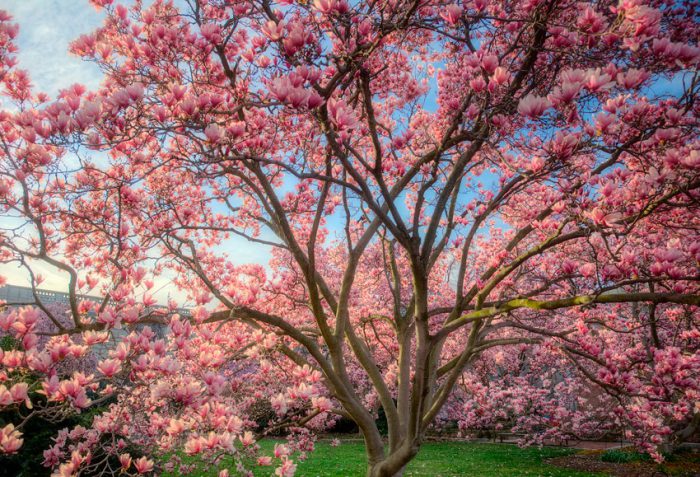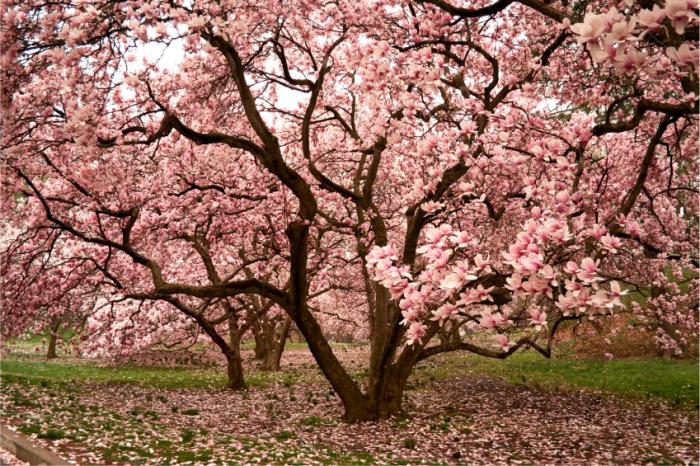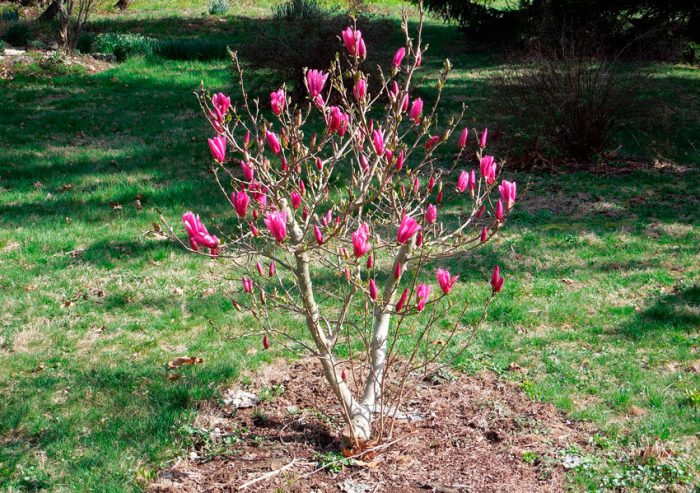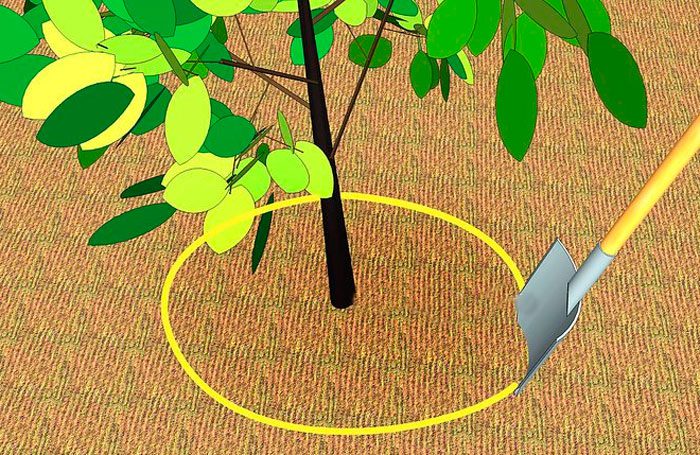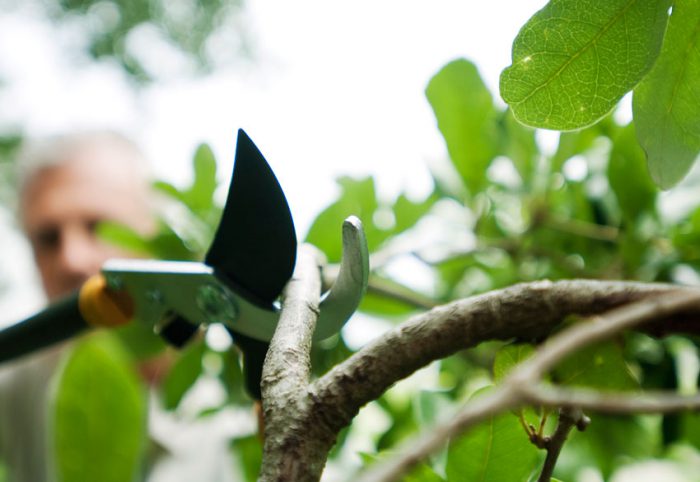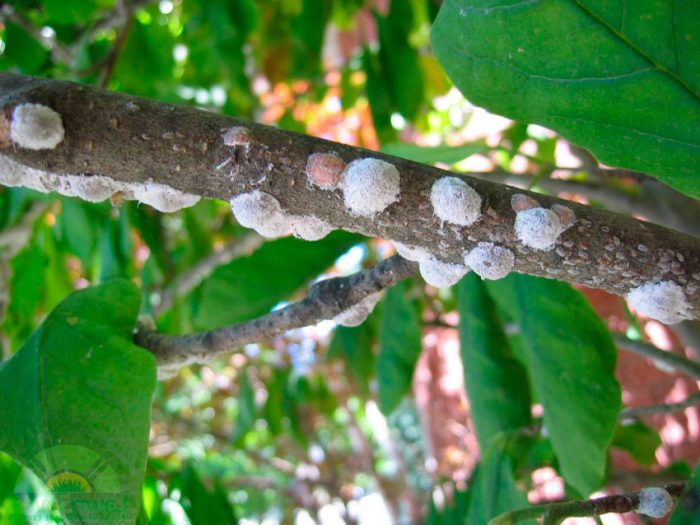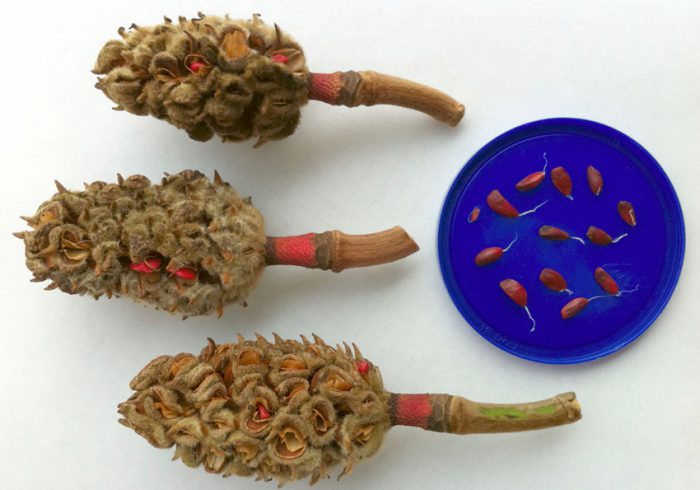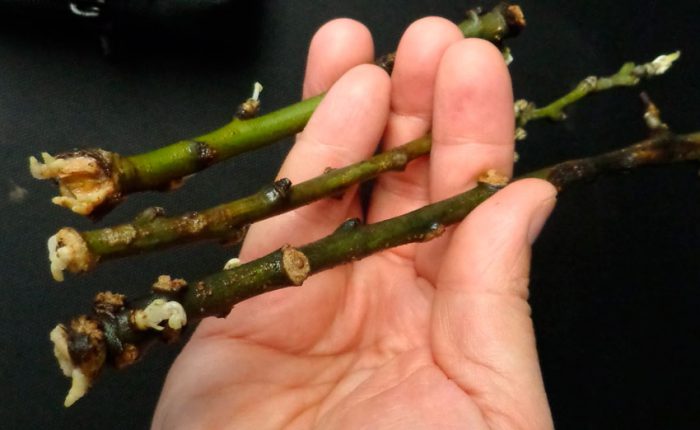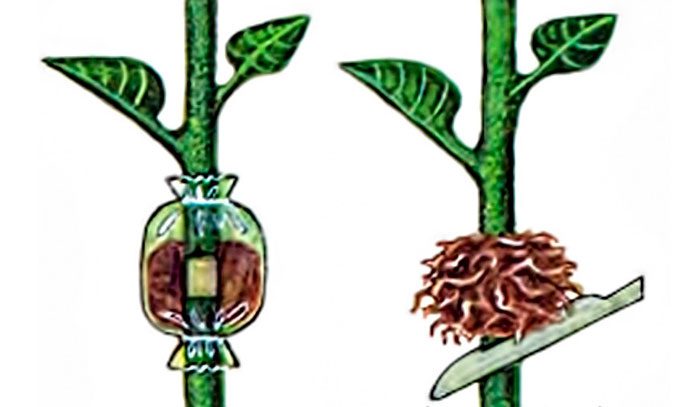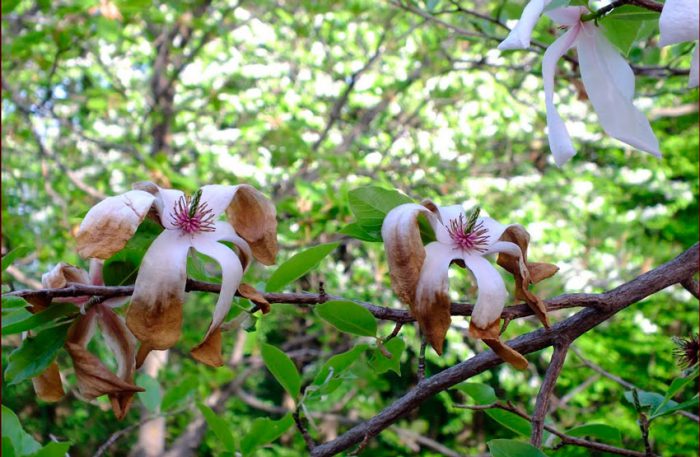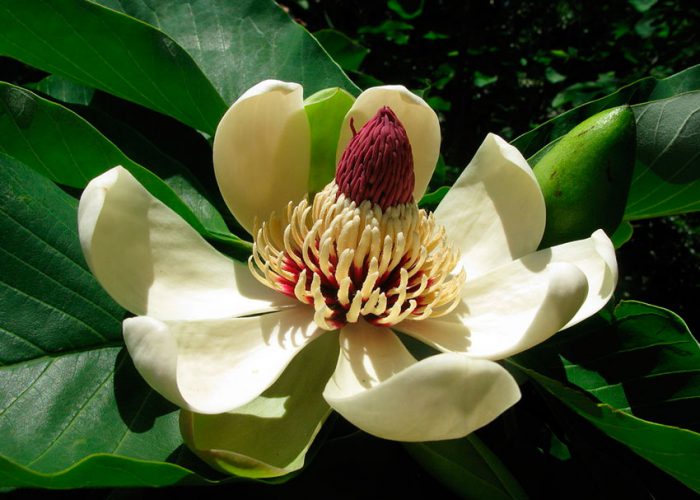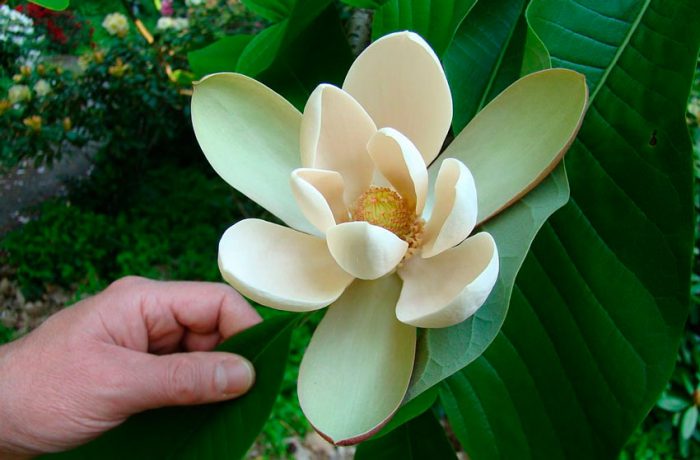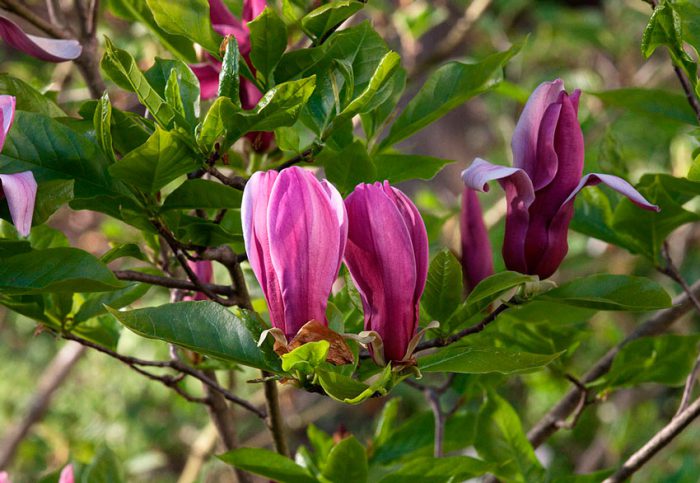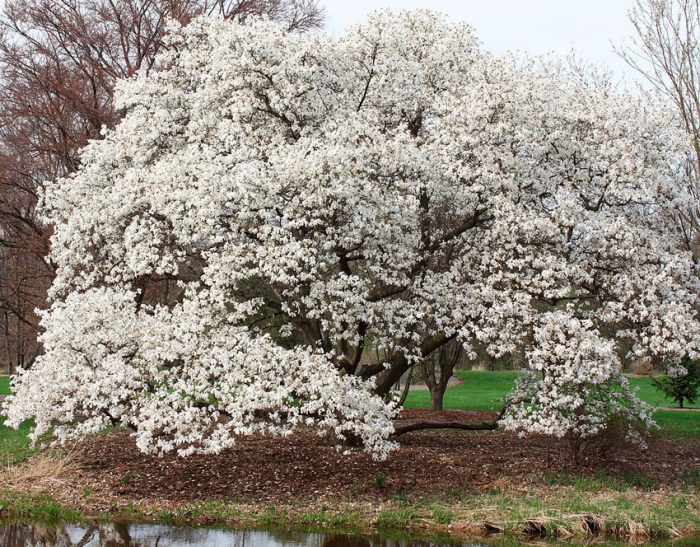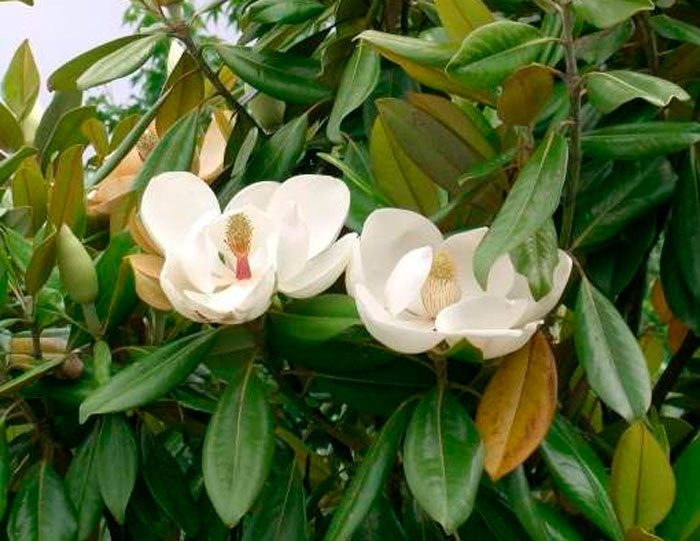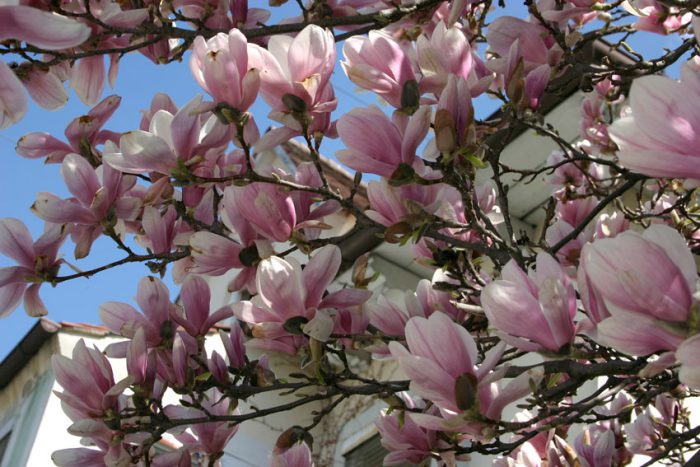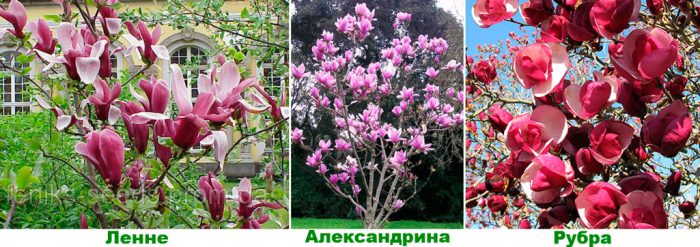The flowering plant magnolia (Magnolia) is a member of the magnoliaceae family. This genus unites more than 200 species. For the first time, these plants appeared in Europe in 1688, and named this genus magnolia C. Plumier in 1703 in honor of Pierre Magnol, who was a botanist. In nature, these plants can be found in regions with subtropical and tropical climates of North America and East Asia. Magnolia is a very ancient plant of the dinosaur era, which spread during the Cretaceous and Tertiary periods. Archaeologists have found a petrified flower of this plant, which is at least 95 million years old. Magnolia was able to survive mainly because it relatively easily and quickly adapts to changeable climatic conditions. In ancient times, bees did not exist yet, and pollination of this flowering plant took place with the help of beetles, which at the moment have retained this ability.
One very beautiful and sad legend is associated with magnolia. The Japanese girl Keiko made wonderful paper flowers for sale, but this work brought her mere pennies, since the flowers were not real. Once, one parrot, whom Keiko sometimes fed, revealed a secret to her: paper flowers can become alive, but for this they need to be watered with a drop of their own blood. But it should be borne in mind that this drop should not be the last. Keiko took advantage of this secret and soon became rich, but the man she fell in love with was so greedy that he forced the girl to work all day long so that he had even more money. And then the moment came when the girl watered the paper flower with the last drop of blood and died. The flower that came to life thanks to this drop was called magnolia. Since that time, the magnolia flower has become a symbol of generosity and nobility of the soul.
Content
- 1 Magnolia features
- 2 Planting magnolias outdoors
- 3 Magnolia Garden Care
- 4 Reproduction of magnolia
- 5 Magnolia after flowering
- 6 Types and varieties of magnolia with photos and names
- 6.1 Magnolia sieboldii
- 6.2 Magnolia obovate (Magnolia obovata), or white magnolia
- 6.3 Magnolia officinalis (Magnolia officinalis)
- 6.4 Magnolia pointed (Magnolia acuminata), or cucumber magnolia
- 6.5 Magnolia stellata
- 6.6 Magnolia liliflora (Magnolia liliflora)
- 6.7 Magnolia kobus
- 6.8 Magnolia grandiflora (Magnolia grandiflora)
- 6.9 Magnolia Sulange (Magnolia x soulangeana)
Magnolia features
Magnolia is a deciduous shrub or tree. The bark is smooth, grayish-ash or brown, it can be scaly or furrowed. The height of such a plant can vary from 5 to 20 meters. On the surface of its stems, large scars from leaf plates are clearly distinguishable, as well as narrow ring-shaped scars from stipules. The kidneys are relatively large. Large leathery whole-edged leaf plates of greenish-emerald color have slight pubescence on the seamy surface, as well as, as a rule, elliptical or obovate. Fragrant single bisexual flowers can be axillary or terminal, their diameter is about 6-35 centimeters, and the color: cream, red, purple, white, pink or lilac. The flower consists of 6 to 12 waxy elongated petals, which overlap each other in a tiled pattern. Such petals are located in 1 or several rows. As a rule, magnolia blooms at the very beginning of spring, however, there are species blooming in the first summer weeks. This plant blooms so beautifully that every gardener would certainly like to decorate his garden with it.
The fruit is a cone-shaped composite leaflet, which consists of a large number of bi-or single-seeded leaflets. Black seeds are triangular in shape and have a red or pink fleshy seed. When the leaflets open, the seeds hang from the seed threads.
Both the shrub and the magnolia tree are very decorative plants. It looks most impressive in spring. Blooming magnolia is a wonderful sight that every person who has seen it at least once cannot forget. However, magnolia is a valuable plant not only because of its beauty. The fact is that in its fruits, flowers and foliage there are essential oils that have a powerful antiseptic effect, they are used for hypertension, rheumatism and various diseases of the digestive tract.
Planting magnolias outdoors
What time to plant
Magnolia cannot be grown in every region. When choosing a place for planting it, one should take into account that this plant is very light-requiring. Choose a well-lit area away from tall trees and provide the plant with good protection from east and north winds. Magnolia can only be grown in light shade in the southern regions. The soil on the site should not be too saline or limed, and excessively wet, sandy or heavy soil is not suitable. A slightly acidic or neutral soil saturated with organic matter is best suited. When purchasing material for planting, it should be remembered that the height of the seedling should be about 100 centimeters, it should have 1 or 2 buds. It is very good if the seedling has a closed root system, this will completely prevent it from drying out. A closed-root magnolia seedling can be transplanted into open soil in spring, summer and autumn.
Most experts advise planting magnolia in open soil in the fall in the second half of October. At this time, the seedling is already dormant. According to statistics, almost 100 percent of the seedlings planted in the fall take root. In spring, a seedling is planted in the garden in April, but it should be remembered that even small night frosts cause significant harm to the adopted trees.
How to plant correctly
The size of the pit for planting magnolia must necessarily exceed the volume of the root system of the seedling by 2 times. The top nutrient layer of the soil, which remained after digging the hole, must be combined with rotted compost. In the event that the soil is too dense, then a small amount of sand should also be added to it.
First, at the bottom of the pit, it is necessary to make a good drainage layer, the thickness of which should be from 15 to 20 centimeters, for this you can use crushed ceramic tiles or broken brick. On top of the drainage, a 15 cm thick layer of sand is poured. And already a layer of a previously prepared nutrient mixture is poured onto the sand (the composition is described above). Then, a seedling should be placed in the center of the pit, while taking into account that after planting its root collar should rise above the level of the site by 30-50 mm. Fill the holes with nutrient mixture and slightly compact the surface of the trunk circle. Planted magnolia needs plenty of watering. After the liquid is completely absorbed into the soil, the surface of the trunk circle must be covered with a layer of peat, and a layer of dry coniferous bark is laid on top of it. Mulching the soil will avoid excessive drying out quickly.


Watch this video on YouTube
Magnolia Garden Care
Magnolia is a moisture-loving plant, therefore it needs systematic watering. Saplings, which are 1-3 years old, especially need abundant and systematic watering. It should be borne in mind that the soil of the trunk circle should not be wet, but only slightly damp, and watered only with lukewarm water. Loosening of the soil near the bush must be done very carefully and only with a pitchfork, since the plant has a surface root system, which is extremely easy to injure with other garden tools. To reduce the number of watering and loosening, experienced gardeners recommend filling the trunk circle with mulch.
Magnolia also needs systematic feeding. The first 2 years, the young plant does not need to be fed, because it has enough nutrients in the soil. Top dressing begins only from the age of three, these procedures are carried out from the beginning to the middle of the growing season. The plant should be fed with a complex mineral fertilizer, while the dosage should be indicated on the package. If you wish, you can make the nutrient mixture yourself, for this combine 1 bucket of water, 15 grams of urea, 20 grams of ammonium nitrate and 1 kilogram of mullein. For 1 adult plant, you need to take 4 buckets of such a nutrient solution. They are watered with magnolia once every 4 weeks. Remember that it is very easy to overfeed her. In the "overfed" specimen, leaf plates begin to dry out ahead of time. When such signs appear, you should stop feeding and increase the abundance of watering.
Transfer
Magnolia reacts extremely negatively to the transplant. If you still need to transplant it, then try to follow the advice of experienced gardeners exactly. First, find the most suitable planting site. The bush is watered abundantly. When digging it, remember that the clod of earth should be as large as possible, then the plant will undergo transplanting much easier and take root faster. To transfer the magnolia to a new planting site, you can use a sheet of plywood or a piece of oilcloth. Further, all manipulations with the plant should be exactly the same as during the initial planting. So, at the bottom of the planting pit, a drainage layer is made, which is covered with sand and earth mixture. Then the magnolia itself is set in the center and the pit is filled with soil mixture, while do not forget that after planting the root collar must necessarily rise above the surface of the site. You should not over-tamp the surface of the trunk circle, you just need to press it slightly.
The transplanted plant must be watered abundantly, and then the surface of the trunk circle is covered with a layer of mulch. If the magnolia was transplanted in the fall, then its roots will need to be protected from the upcoming frost; for this, a mound of dry soil is created on the surface of the trunk circle. The branches and trunk of such a plant for the winter must be wrapped in cloth.
Magnolia pruning
Magnolia is not pruned for crown formation. Sanitary pruning is carried out only after the plant has faded. In this case, you need to cut out all dry branches affected by winter frosts, as well as those that thicken the crown, do not forget to remove the wilted flowers. Places of fresh cuts should be coated with garden varnish. Pruning is not done in spring, the fact is that such a plant is characterized by extremely intensive sap flow, and the resulting wounds can lead to its death.
Pests and diseases
For many years, it was believed that magnolia is not affected by any disease or pest, but at the same time it can still have many problems. For example, chlorosis may develop, from which yellowish spots begin to appear on the surface of the leaf plates, but the veins do not change their green color. Chlorosis indicates that the soil contains too much lime, which negatively affects the development and growth of the magnolia root system and often leads to the death of the entire plant. The soil can be corrected by introducing coniferous soil or sour peat into it. You can also use chemicals available in any specialty store, for example, iron chelate.
Growth and development of magnolia can become slower due to the fact that the soil is oversaturated with nutrients, which leads to salinity. To understand that the plant is overfed, you can conduct a thorough inspection in the last days of July, you can find the drying edges of old leaf plates. If there are signs of overfeeding magnolia, then it is necessary to stop fertilizing and increase the abundance of watering.
Mealybugs, rose thrips and peach aphids can settle on such a plant, while transparent or spider mites harm it during a drought. These pests feed on plant sap, which causes significant harm to magnolia. So, the fall of its foliage can begin in July or August. In some cases, due to pests, the plant can be weakened so much that next year it will not have any growth at all. Also, these pests are carriers of viral diseases that cannot be cured. To get rid of pests, you should use acaricides, for example, a bush can be treated with Aktara, Aktellik or another means of similar action.
In winter, rodents can cause significant harm to the plant, which gnaw at the root collar and roots. But to understand if there are such problems, you will have to remove the topsoil. Found gnaws will need to be sprayed with Fundazole solution (1%). And remember, in order to prevent rodents, you need to cover the magnolia tree trunk for the winter only after the top layer of the soil freezes.
When grown in mid-latitudes, magnolia can contract fungal diseases such as powdery mildew, black fungus, scab, seedling rot, gray mold, or botrytis. The affected bush can be cured only if the disease is detected quickly enough and the plant will be treated with a fungicide solution as soon as possible. Don't forget to cut back on watering as well. In some cases, to obtain the desired result, the plant must be sprayed several times. If the bush is infected with bacterial spot, then it will need to be treated with copper sulfate.
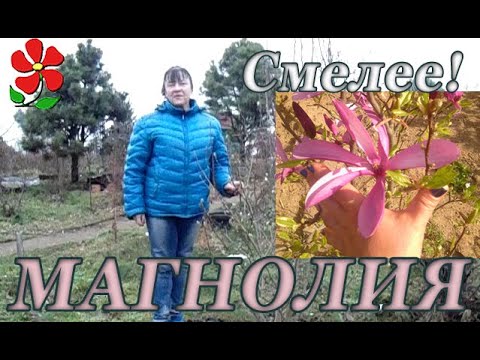

Watch this video on YouTube
Reproduction of magnolia
Magnolia can be propagated by seeds, as well as by layering, cuttings and grafting. But it should be taken into account that in order to preserve the varietal characteristics of the plant, it must be propagated exclusively in a vegetative way. However, when growing magnolia from seeds, it is often possible to obtain a new variety, shape or variety. And the generative way of reproduction is the simplest.
Seed propagation
Seeds ripen in September. Collect the stems and lay them out on a piece of paper. Then the seeds are shaken out and immersed in a container with water, where they should stay from 2 to 3 days. Then they are rubbed through a sieve, so you can remove the seedlings. Next, the seeds are washed in soapy water, which removes oily plaque from them, and then they are thoroughly rinsed in clean running water. Seeds need to be stratified before sowing. To do this, they are folded into a polyethylene bag, which must be filled with moistened sphagnum or sand (1: 4). Place the package on the middle shelf of the refrigerator for at least 20 days.
The stratified seeds must be taken out of the refrigerator, put them for a while in a fungicide solution for disinfection. Then the seeds are laid out in moistened moss and wait until they bite. If done correctly, the sprouts will give more than half of the seeds. If we neglect stratification, then there will be not so many seedlings.
Make a groove 20 mm deep and spread the seeds in it, which must be covered with a centimeter layer of the substrate. This plant has a rod system of roots, therefore, for sowing, it is necessary to take a high container, the depth of which will be at least 0.3 m.Transplantation into open ground is carried out after the threat of return frosts is left behind, while the seedlings must be carefully transferred into the holes. For wintering, young bushes should be covered with dry peat.
Cuttings
To harvest cuttings, you need to choose young plants, while you need to have time to cut them before the buds bloom. It is best if the lower part of the cutting is lignified, and the upper part is green. The cuttings are planted in the last days of June or the first - in July, for this they use a greenhouse, since it will be possible to maintain the required temperature and humidity of the air and soil in it. The cuttings are planted in sand or a mixture consisting of peat, vermiculite, sand and perlite. The air temperature in the greenhouse should be kept at around 20-24 degrees, in this case the cuttings will be able to take root in 5-7 weeks. If you take a stalk from a large-flowered magnolia, then it should be borne in mind that it can take 2 times longer to root it. Try to keep the air temperature within the recommended range. The fact is that if it is cooler, the rooting of the cuttings will slow down significantly, and the temperature exceeding 26 degrees can destroy the plant. While the cuttings are in the greenhouse, do not forget to ventilate it systematically, and also make sure that the soil in it is slightly damp all the time.
How to propagate by layering
Reproduction by layering is only suitable for shrub magnolias. In springtime, choose a branch that grows very close to the ground. At the base, you need to drag it with a soft copper wire, then the branch is bent to the ground and fixed in this position. In the place where the branch touches the soil, it must be sprinkled with soil so that a small mound is obtained. To bring the moment of the appearance of roots closer, it is necessary to make a circular incision on it in the place where the branch touches the ground.
For reproduction, air layers are sometimes used. In the last spring or first summer weeks, it is necessary to select a branch and make a circular cut of the bark on it, the width of which should be from 20 to 30 mm. Cutting must be done carefully so as not to injure the wood. Next, the cut is processed with Heteroauxin, and then the wound is covered with moistened moss and wrapped with cling film, which must be fixed below and above the cut. After that, this branch is tied to the nearby branches, which will avoid injury due to strong gusts of wind. The moss should be slightly damp all the time. To do this, several times a month you need to "inject" water into it through a syringe. The roots should appear after 8-12 weeks.In the autumn, the cuttings should be disconnected from the mother plant, and they are grown indoors.
Magnolia after flowering
How to care after flowering
Magnolia blooms begin in spring or early summer. A magnolia covered with flowers is the queen of the garden trees. After the plant has faded, you will need to prune it for sanitary purposes. To do this, it is necessary to cut off all wilted flowers, as well as branches and stems injured and damaged by frost, as well as those that grow inside the crown. Non-flowering magnolia is also very decorative, as it has beautiful leathery leaf plates.
Wintering
Preparing the plant for winter should be done in late autumn. The shelter should be good and reliable, because even if you are growing a winter-hardy magnolia, it can still freeze, especially if the winter is windy and with little snow. To exclude freezing of the plant, its trunk must be wrapped in burlap in 2 layers, while trying to prevent the delicate branches from being injured. After the first frost, the surface of the trunk circle must be mulched with a thick layer.


Watch this video on YouTube
Types and varieties of magnolia with photos and names
The largest collections of magnolias are in the UK, namely at the Royal Botanic Gardens and at the Arnold Arboretum introduction center. There is also a fairly beautiful collection in Kiev. The species that are most popular with gardeners will be described below.
Magnolia sieboldii
The height of such a deciduous tree is about 10 meters. However, most often this species is represented by a shrub. Its leaf plates are broadly elliptical, and they reach 15 centimeters in length. On a thin pubescent peduncle there is a slightly drooping, fragrant white cup-shaped flower. Flowers in diameter can reach 7-10 centimeters. This species is one of the most winter-hardy, it is able to withstand short frosts down to minus 36 degrees. Cultivated since 1865
Magnolia obovate (Magnolia obovata), or white magnolia
This species comes from Japan and from the island of Kunashir, which is located in the Kuril Islands. The height of this deciduous tree is about 15 meters. The color of the smooth bark is gray. At the ends of the stems, 8–10 leaf plates are collected. The diameter of the spectacular cream-white flowers is about 16 centimeters, they are distinguished by the fact that they have a spicy scent. The length of the rich red fruit is about 20 centimeters. Such a plant looks spectacular all year round, it is shade-tolerant and frost-resistant, but at the same time it is demanding on the level of humidity in the air and soil. Cultivated since 1865
Magnolia officinalis (Magnolia officinalis)
The homeland of this species is China. This plant is considered an analogue of medicinal magnolia, but its leaf plates are larger. The large, fragrant flowers are superficially similar to water lilies, but they have narrower petals that taper towards the top. At home, this species is used as a medicinal plant, and in middle latitudes it can be found extremely rarely.
Magnolia pointed (Magnolia acuminata), or cucumber magnolia
This plant comes from central North America. Under natural conditions, it prefers to grow in deciduous forests at the mountain foot, as well as along the rocky banks of mountain rivers. This deciduous tree can reach a height of about 30 meters. In a young plant, the crown shape is pyramidal, but it gradually becomes rounded. Elliptical or oval leaf plates reach 24 centimeters in length. Their front side is colored dark green, and the back side is greenish-gray, there is a short pubescence on its surface. The diameter of the bell-shaped flowers is about 8 centimeters, they are painted in a greenish-yellow color, in some cases there is a bluish bloom on the surface. This species is the most frost-resistant of all.This species has a shape with rounded or heart-shaped leaf plates at the base. Canary-colored flowers are not as large as those of the main species. In the United States, experts obtained hybrid magnolias by crossing the lily-flowered magnolia and the pointed magnolia, they are combined under the name of Brooklyn magnolia.
Magnolia stellata
This type is one of the most beautiful and graceful. He comes from Japan. The plant is a shrub or not a very large tree, the height of which can reach 250 centimeters. The branches are bare, brownish-gray in color. The shape of the leaf plates is narrowly elliptical, their length is about 12 centimeters. The diameter of the unusual flowers is about 10 centimeters, they have a large number of snow-white petals of an elongated ribbon-like shape, they extend in all directions, which is similar to the rays of a star. There are 2 decorative forms: Keyskaya and pink. Several varieties and hybrids are also popular with gardeners. For example, Susan's magnolia is a variety that has flowers with a dark reddish crimson outside and a paler color on the inside. This variety is part of a series of hybrids with female names: Betty, Pinky, Jane, Judy, Anna, Randy and Ricky. This series was born in the fifties of the last century.
Magnolia liliflora (Magnolia liliflora)
This species is very popular with gardeners. Presumably, the homeland of such a plant is eastern China, in Europe it appeared in 1790. The flowering is lush, the diameter of the flowers with a subtle smell is about 11 centimeters, they are very similar in shape to a lily. Their inner surface is white, and the outer one is purple. The decorative form of this type of Nigra (Nigra) deserves special attention: the outer surface of its flowers is ruby-red, and the inner surface is lilac-white, flowering begins in the last days of April or the first days of May.
Magnolia kobus
The homeland of such a plant is South Korea, as well as central and northern Japan. It got to New York in 1862, and from there it was brought to Europe in 1879. Under natural conditions, the height of a tree may be 25 meters, but in culture it does not exceed 10 meters. Wide, obovate leaf plates have a pointed apex. Their front surface is deep green, and the back is painted in a paler shade. The diameter of the fragrant white flowers is about 10 centimeters. The first flowering of such a magnolia can be seen only when it turns 9-12 years old. This type is frost, dust and gas resistant. The northern form is a plant with larger flowers, which is even more hardy.
Magnolia grandiflora (Magnolia grandiflora)
Originally from the southeast of North America. The slender barrel has a cylindrical shape. The crown has a very effective shape. The color of large glossy leaf plates is dark green. The diameter of the white flowers is about 25 centimeters, they have a pungent spicy smell. The fruits are also highly decorative, they are very bright and have a cone-like shape. While the plant is young, it is characterized by slow growth, so the annual growth is only 0.6 m. It has low winter hardiness, it is able to withstand frosts of at least minus 15 degrees. This species grows well in urban conditions, it is durable and highly resistant to pests and diseases. Basic decorative forms:
- Narrow-leaved... The leaf plates are narrower compared to the main view.
- Lanceolate. The foliage is elongated.
- Famous... The leaf plates are very wide, and the flower diameter is about 0.35 m.
- Round-leaved... The leaf plates are colored very dark green. The diameter of the flowers is about 15 centimeters.
- Early... Flowering begins earlier than the main species.
- Exon... This tall tree has a narrow pyramidal crown shape.The leaf plates are oblong and have pubescence on the lower surface.
- Do it... The crown shape is strictly pyramidal.
- Hartvis... The shape of the crown is pyramidal, the foliage is wavy.
- Draconic... The crown is lowered very low. Arcuate hanging branches touch the ground and take root quickly.
- Gallison... Has greater frost resistance compared to the main species.
Magnolia Sulange (Magnolia x soulangeana)
This hybrid was born in 1820 thanks to the Frenchman E. Soulange, who was a scientist. At the moment, more than 50 forms of such a hybrid have been registered, and all of them are very popular in almost every country. The height of such a deciduous shrub or tree does not exceed 5 meters. The length of obovate leaf plates is about 15 centimeters. The diameter of the goblet flowers can vary from 15 to 25 centimeters, they are fragrant, and in some cases they have no smell at all. They can be painted in various shades from purple to light pink. A plant with white flowers is extremely rare. This magnolia is resistant to adverse environmental influences and is not demanding on the composition of the soil. The most popular garden forms:
- Lenne... The inner surface of the fragrant flowers is white, while the outer surface is purplish pink.
- Alexandrina... The magnolia is about 8 meters high and is drought tolerant. The outer surface of the flowers is dark purple and the inner one is white.
- Rubra (red)... The outer surface of the flowers is reddish-pinkish.
- Nemetsa... The shape of the crown is pyramidal.
Also, this hybrid has a large number of varieties.
In addition to the species described above, gardeners cultivate willow, large-leaved, Lebner's, nude, three-petalled, or umbrella magnolia, etc.


Watch this video on YouTube

